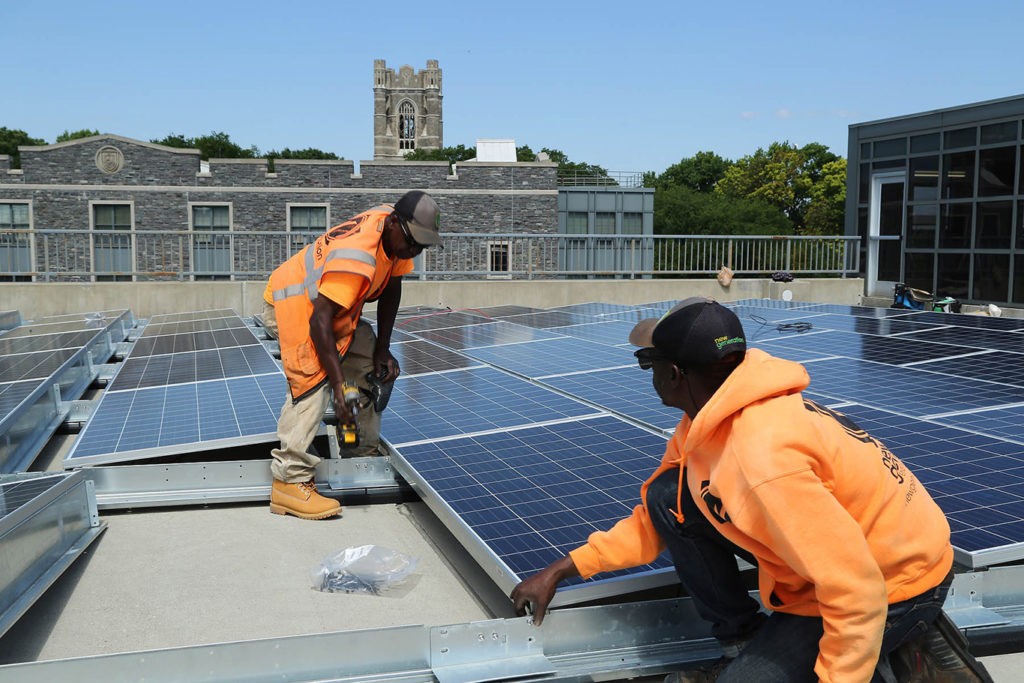Author: Stephanie Albert, junior
Honors sophomore Gabby Perez is an Environmental Studies major and the United Student Government’s Sustainability Committee Chair. I sat down with her during the February 12th snowstorm to chat about Fordham and the Sustainability Committee’s efforts to make Fordham more sustainable.

As reported on the Fordham Changemaker’s blog “20% of Fordham’s energy is offset by a solar farm in Staten Island.” The University also runs partly on renewable energy from solar panels on top of the parking garage. Though the University has expressed concerns about the cost of solar panel installation in the past, the Climate Action Plan: 2018 Annual Executive Update released in July states that the University will annually save about $190,000 from solar panels installed on top of the parking garage, as well as the Staten Island Project. Both initiatives demonstrate that the University could save money in the long term despite the initial costs of switching to renewable energy.
The University has also made small steps towards becoming more sustainable all around campus. Gabby commented that tech recycling bins, which can be used to recycle electronic devices that were recently installed on campus are a very good measure to move towards being more sustainable. Some other examples include changing all of the light bulbs to LEDs, having water bottle refilling stations in a few locations on campus, and using paper bags in dining locations. Both New York City and universities at large are taking steps to minimize their environmental footprint; Fordham is joining them by continuing to make environmentally sustainable enhancements to the campuses. Though, there is more work to be done.
USG’s Sustainability Committee currently has a petition for Fordham to commit to 100% renewable energy by 2040. Two members of the Committee are working specifically on this campaign with Environment America, an organization that helps university groups press their administrations to move towards renewable energy. This partnership followed Environment America reaching out to the Sustainability Committee to expand their impact through connecting with more college campuses.This semester, the Committee is hoping to stage demonstrations and showcases on Eddie’s [the main green space on the Rose Hill campus] to inform the community about the dangers of fossil fuels and to try to persuade the University to move towards renewable energy. Gabby also shared that although they have a long way to go, the Sustainability Committee is looking to have the University divest from fossil fuels. This would mean that the University no longer invests money in the stock of fossil fuel companies. This is an aspect of the Transparency Initiative that aims to get the University to bring clarity about where the money from student tuition goes and be more specific in the breakdown of where money is spent when they release their financial report. Gabby cited an article from The Ram, the main Rose Hill newspaper, stating that $10,000 is spent on plastic utensils and plates per week each time the conveyer belt in the Marketplace, the major dining location on the Rose Hill campus, breaks down. The University could prevent this expense and be more environmentally friendly by finding a way around this solution to a recurring problem.
As for what students can do to be more environmentally friendly in their daily lives, Gabby says, “Buy less and take care of what you have. Overconsumption, especially in wealthier nations like the United States, is what fuels the environmentally-destructive and exploitative corporations that dominate today’s global capitalist system. Be a conscious consumer. Think about your connection to the people who make your products. Think about where your products will end up when you’re done with them. Your dollar is your vote; know that you as a consumer have so much power! The most sustainable thing to do in any situation is to use what you have. If you can’t do that, see what you can borrow. Only after you find you have no other options, buy something — but try to make the choice that will mean you won’t have to buy it again any time soon.”
Let’s hope that we can all can continue to look for ways to be more sustainable and to lessen our environmental footprint.